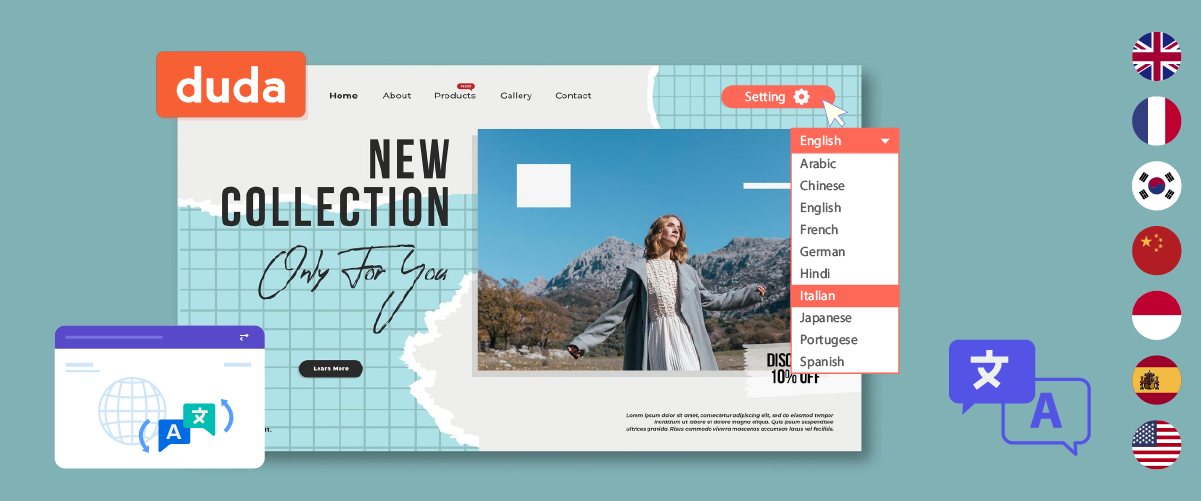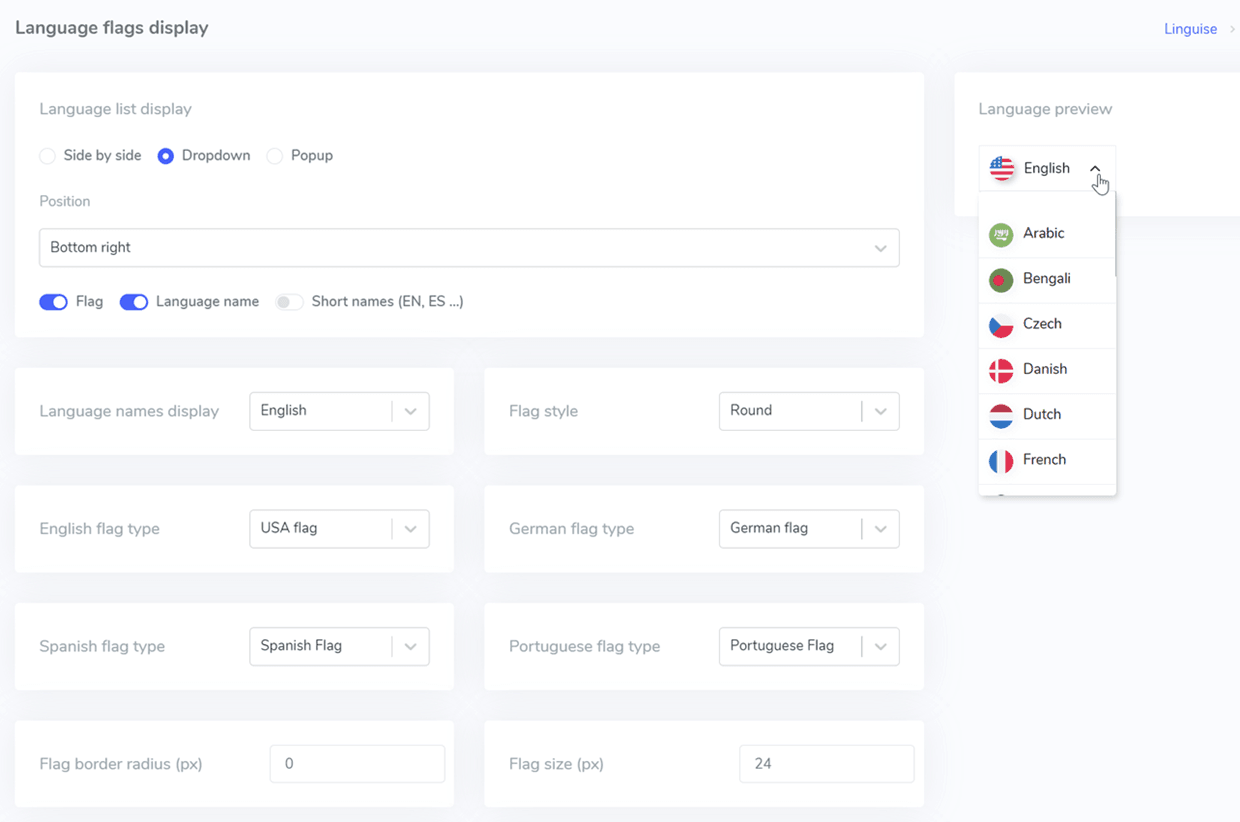Implementing automatic translation on Duda can significantly enhance your website’s global reach and user experience. As businesses expand their online presence internationally, the ability to offer content in multiple languages becomes crucial. Duda, a powerful website-building platform, provides robust features to make this process seamless and efficient.
It can break down language barriers and demonstrate your commitment to serving a diverse audience. This feature can increase engagement, improve user satisfaction, and raise conversion rates as visitors can easily access your content in their preferred language. This guide’ll explore the steps to set up and optimize automatic translation on your Duda website, ensuring your message resonates with a global audience.
Why should you implement automatic translation on the Duda website?
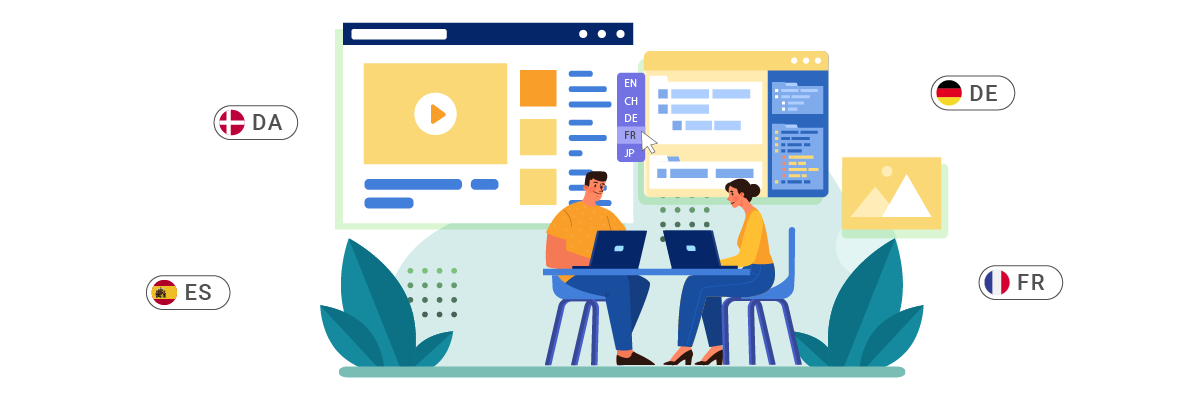
Implementing automatic translation on Duda offers numerous benefits that can significantly impact your website’s performance and reach.
The first primary advantage of automatic translation is its expanded global reach. According to a study by Common Sense Advisory, 76% of consumers prefer to buy products in their native language. By offering your content in multiple languages, you can tap into new markets and attract customers who language barriers might otherwise deter.
Second, enhanced user engagement is another compelling reason to implement automatic translation on Duda. When visitors encounter content in their preferred language, they’re likelier to spend time on your site and interact with your offerings. This increased engagement can lead to lower bounce rates and higher conversion rates. By providing a seamless multilingual experience, you’re catering to user preferences and building trust and credibility with your international audience.
Moreover, automatic translation can significantly boost your website’s SEO performance. A compelling case study from Quick Sprout demonstrates this impact. They experienced a remarkable 47% increase in search traffic after shifting to a multilingual website design. This substantial growth underscores the power of language accessibility in driving organic traffic. By implementing automatic translation on Duda, you create multiple entry points for users worldwide to discover and engage with your content.
Examples of implementing a multilingual website with Duda web builder
According to trends.builtwith.com, there are dozens of sites built using the Duda web builder. Therefore, this time, we will discuss some examples to give you an idea of whether you are considering creating a multi-language Duda site.
Forest Lawn

The Forest Lawn website, as seen in the image, appears to be for a funeral service and memorial park located in Arcadia, California. One of the key features of this website is the language options prominently displayed in the top right corner. Users can choose between English, Traditional Chinese (indicated by “繁體中文”), and Spanish (“Español”). This multilingual approach demonstrates Forest Lawn’s commitment to serving a diverse community in the San Gabriel Valley area. By offering content in multiple languages, they ensure their services are accessible to a wider range of potential clients, showing cultural sensitivity and inclusivity in their business approach.
Global Research

The Global Research website, based on the image, is a platform dedicated to research and news on global issues. At the top right of the page, the website offers an impressive array of language options, including Italian (Italiano), German (Deutsch), Portuguese (Português), Serbian (srpski), Arabic (العربية), Chinese (中文), and more. This extensive language selection reflects the website’s global focus and its aim to reach a broad, international audience.
How to implement automatic translation on Duda
After reviewing examples of multilingual websites built with Duda, we will investigate enabling automatic translation through an external service. Several services offer quick and straightforward website translations with minimal configuration. A notable example is Linguise automatic translation website.
Linguise seamlessly integrates with various CMS platforms and website builders, including Duda. Below are the steps to set up Linguise for automatic translation on Duda.
#1 Register your Linguise account & Duda domain
First, create a Linguise account, which offers a 30-day free trial to get you started. Once you’ve signed up and accessed the Linguise dashboard, you’ll be prompted to register your domain to authorize translations.
To do this, simply copy your domain name (including the https://) and choose “Other Cloud Hosted CMS” as the platform.

Next, select your source language and the languages you want to translate your site into.

#2 Automatically add domain DNS using Entri
Once you’ve successfully registered your website in the Linguise dashboard, you’ll have two installation options.
If you want to add the necessary DNS records automatically, click “Connect your DNS automatically”. This feature, Entri, will handle the DNS setup for you, making installation easy. Alternatively, you can manually copy the DNS records into your domain provider.
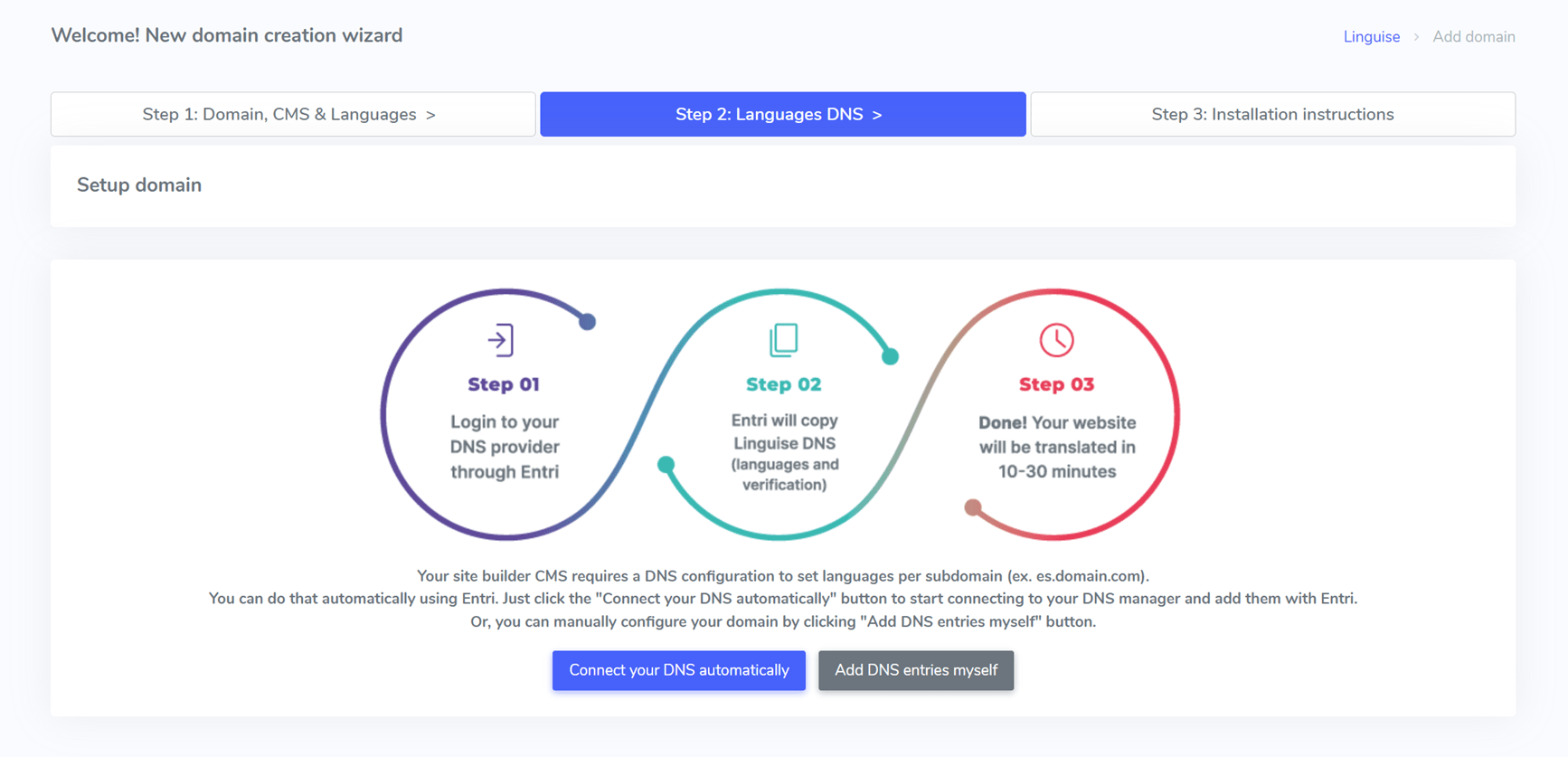
After selecting the automatic option, Entri will analyze your website’s URL and check the public DNS records. Based on this, it will determine the required DNS settings.

Next, click “Authorize with [your domain provider]” (for example, Cloudflare). You’ll be redirected to your domain provider’s login page, where you can log in and proceed.
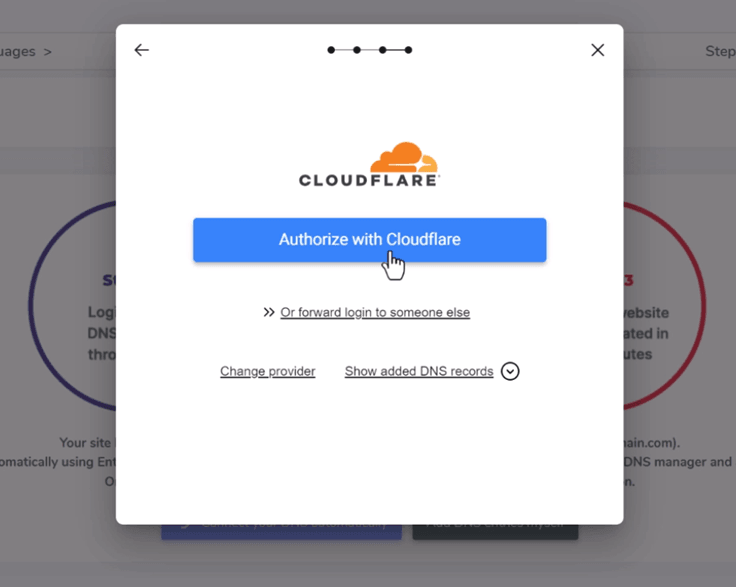
Once logged in, Entri will automatically add the appropriate DNS records—one DNS per language and a TXT DNS for the validation key.
You should see the DNS records added to your domain, and Entri will confirm when all DNS settings have been configured successfully. The translation feature will become available once the DNS entries propagate, typically within 20-30 minutes.
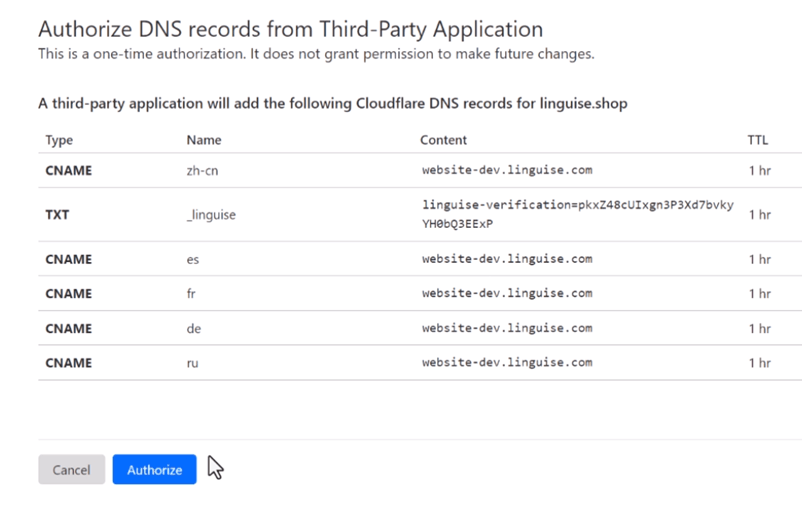
For those who prefer manual installation, you can follow the manual steps provided below.
#3 Copy DNS records
Once your domain is validated, you’ll be directed to a screen where you can copy the necessary DNS records. These records are crucial for loading your multilingual pages, such as fr.domain.com, es.domain.com, etc.
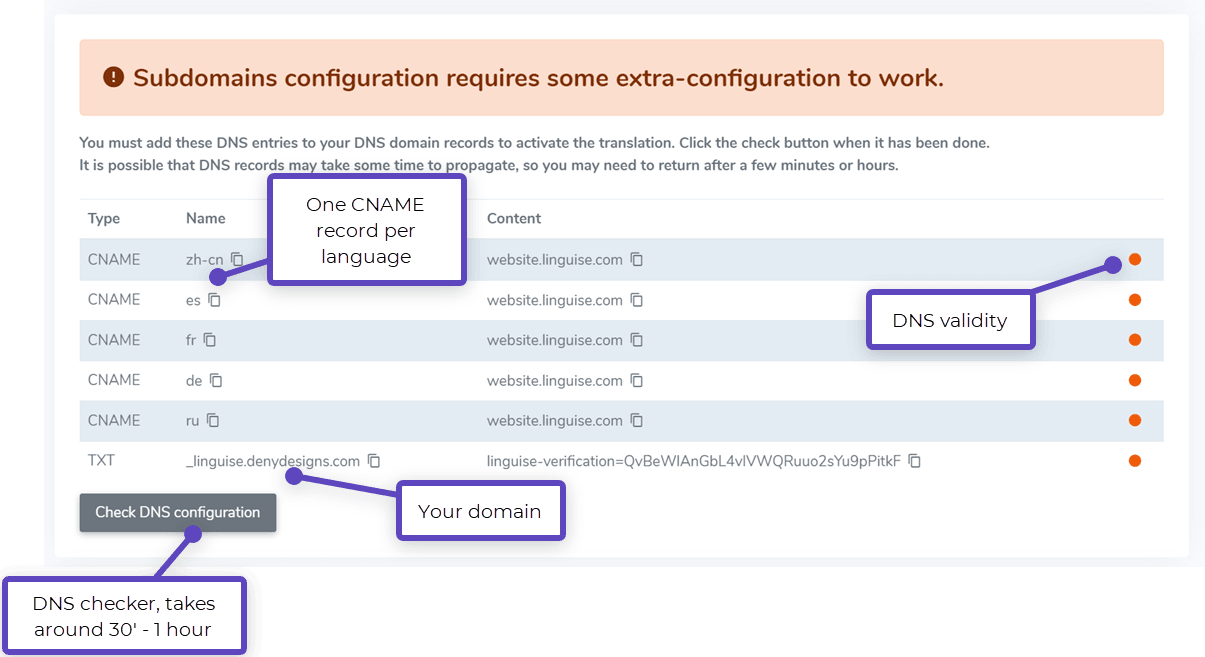
Next, log in to your domain manager and navigate to the DNS setup section. You will need to copy the following:
- A TXT record for domain verification
- One or more CNAME records for the languages
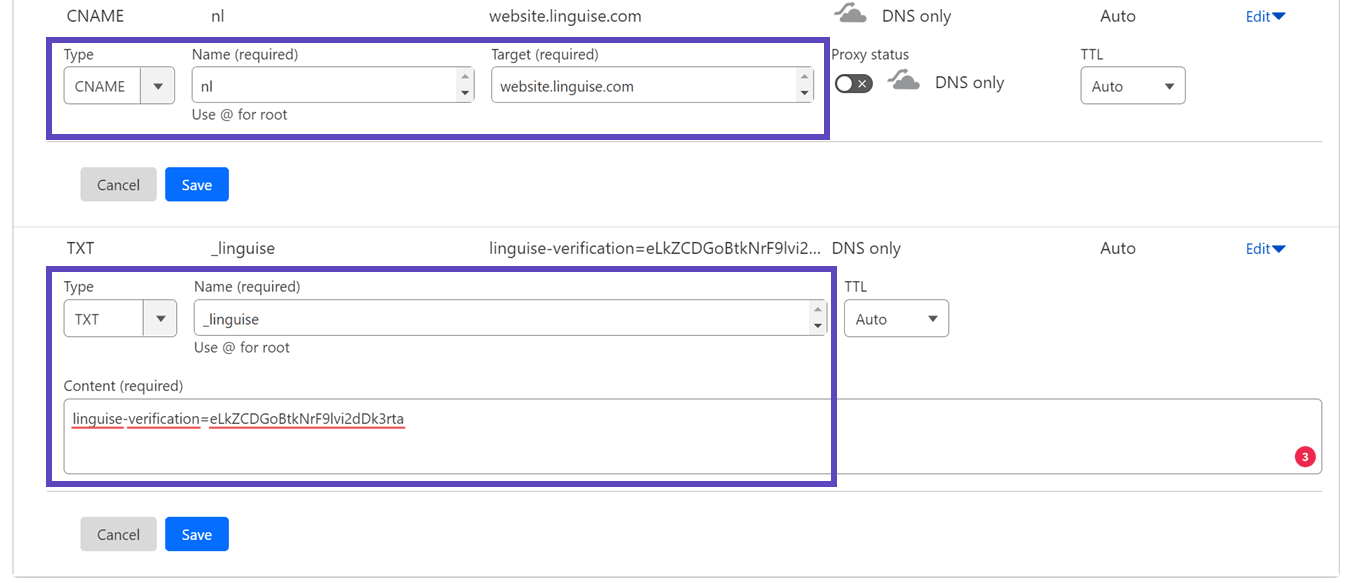
Here’s an example of how each record (TXT and CNAME) should look. After adding all the records, your configuration should resemble this setup.
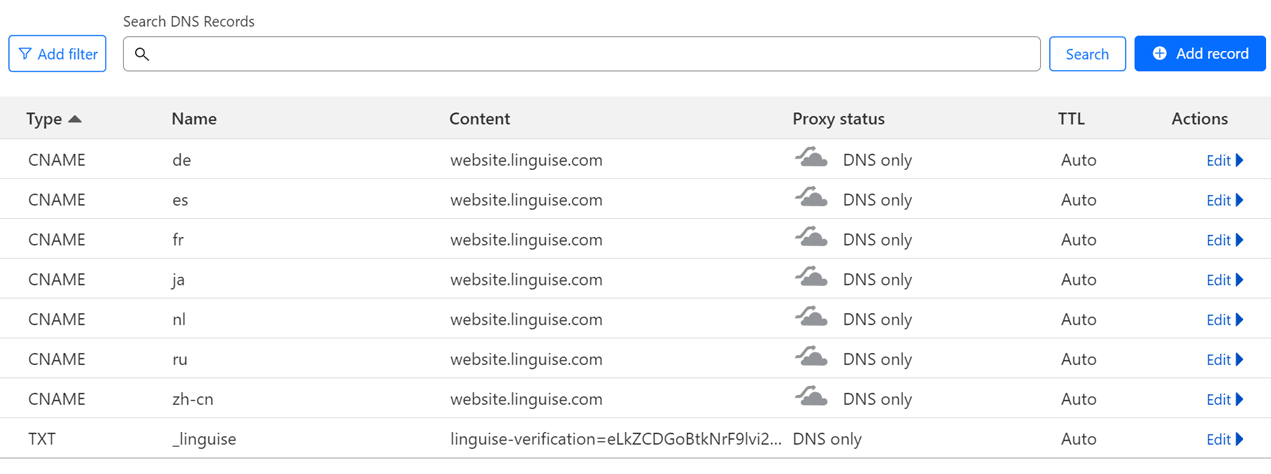
#4 Verify DNS validation
Once you’ve added all the DNS records to your domain, you can verify the DNS propagation by clicking the “Check DNS configuration” button.
DNS validation typically takes 30 minutes to an hour. Once completed, you should see green dots next to the DNS entries in your Linguise dashboard. The final step is to add the language switcher with country flags to complete the setup for translating your Duda website.

#5 Activate the automatic translation on the Duda website
The language switcher is a flag popup that allows users to select their preferred language. To enable it, copy the provided code into the head section of your Duda site pages. This will ensure the flag language switcher is automatically displayed on your public website.
The code is at the end of the domain registration process or within your domain settings. Copy it to your clipboard.

Next, open your website editor and click on ‘Settings’ from the left-hand menu.
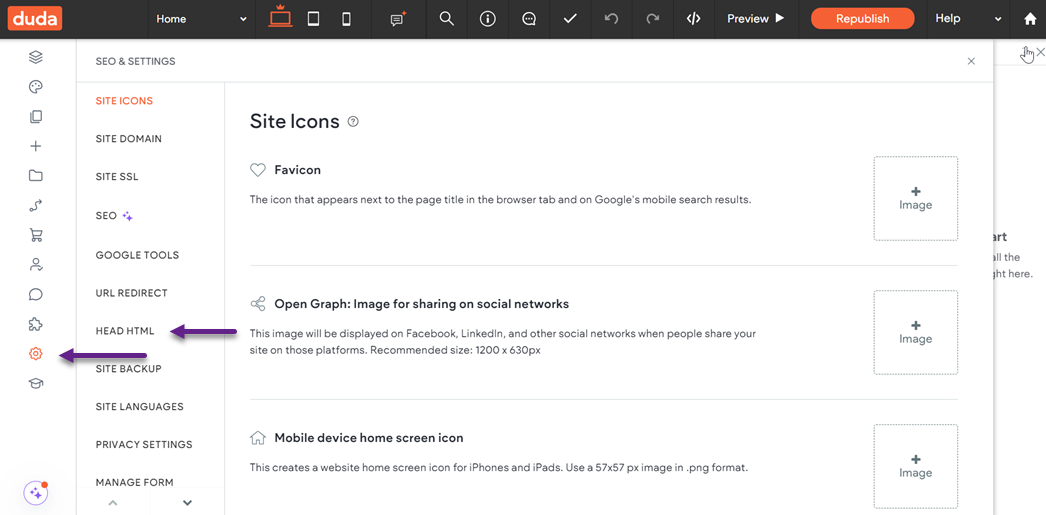
Then, select ‘HEAD HTML,’ paste the Linguise script, click ‘Save’, and publish your site.
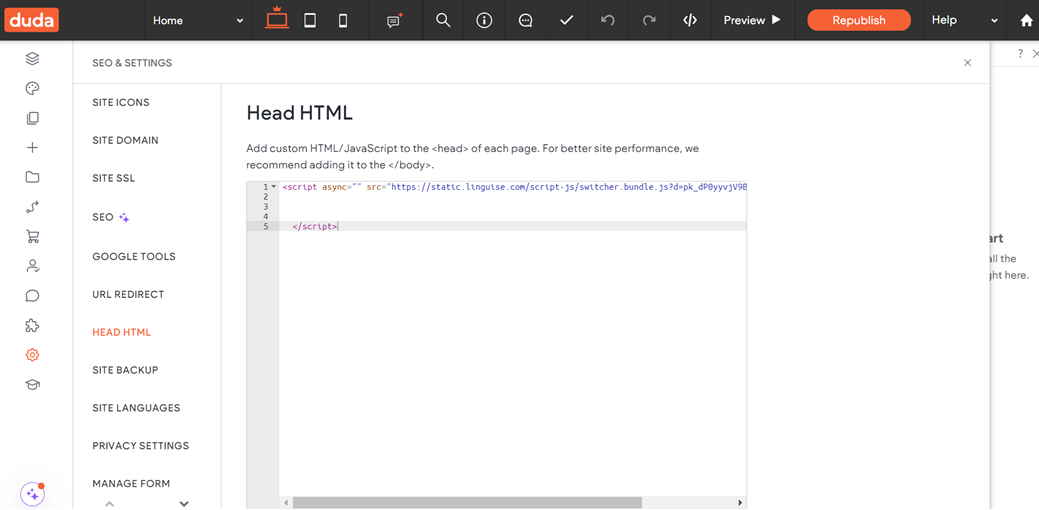
#6 Customize language switcher design on the Duda website
You can customize the language switcher directly from the Linguise dashboard by navigating to Settings > Language flags display. Any changes made here will automatically update on your website.
On the right side of the screen, you’ll see a preview of the language switcher. The following elements can be adjusted.
- Layout options, side-by-side, dropdown, or popup
- Position of the language switcher
- Content of the language switcher
- Language names in English or the native language
- Flag shapes and sizes
- Colors and box-shadow effects
#7 Automatic translation Duda website
After customizing the language switcher on the Duda website, here is how the website looks like with Linguise automatic translation installed.
Here there is a language switcher on the top right which consists of several languages.

Then, we will try to translate from English to Russian.

Automatic translation on Duda with Lingusie

Linguise seamlessly integrates automatic translation into your Duda website, supporting over 80 languages and over 40 CMS platforms. This service makes it easy to transform your website into a multilingual platform, ensuring an enhanced user experience for global visitors.
- Front-end live editor for quick translation adjustments – allowing you to make instant translation adjustments. You can fine-tune translations for accuracy and collaborate with professional translators to ensure cultural and contextual precision.
- Global translation exclusion – offers exclusion rules to manage challenging translations. These rules allow you to omit specific terms, inline content, or even entire pages from being translated, ensuring clarity and consistency where needed.
- Dynamic content handling – which ensures that content generated dynamically, such as checkout processes or popups, is translated seamlessly. You can easily manage this by activating the dynamic translation toggle.
- Comprehensive multilingual SEO support – you can optimize your Duda site for multilingual SEO. It helps generate multilingual sitemaps, apply hreflang tags, set up canonical URLs, and translate URLs and meta descriptions. These features boost your site’s visibility in search engines and improve accessibility for users in different languages.
Conclusion
Implementing automatic translation into your Duda CMS website can greatly extend your reach, enhance user engagement, and increase conversion rates. With Linguise, managing multilingual content becomes easy. It provides a smooth experience for users in various languages while optimizing your SEO performance.
Linguise offers powerful features such as front-end live editing, dynamic content translation, exclusion rules for specific terms, and complete SEO support. These tools make it a top solution for adding automatic translation to Duda. Get started by creating a Linguise account today and turn your website into a multilingual success.

